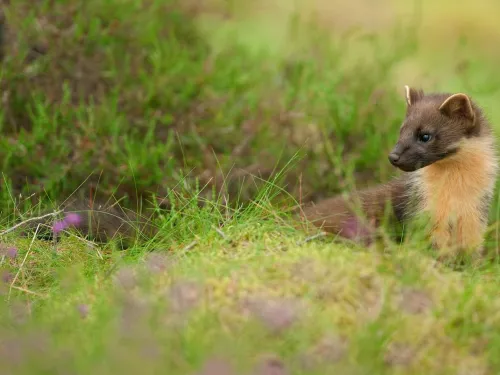
South East Pine Marten Restoration Project
Kent Wildlife Trust and Wildwood Trust, in collaboration with Sussex Wildlife Trust, Ashdown Forest and Forestry England, are assessing the possibility of restoring pine martens to the South East.
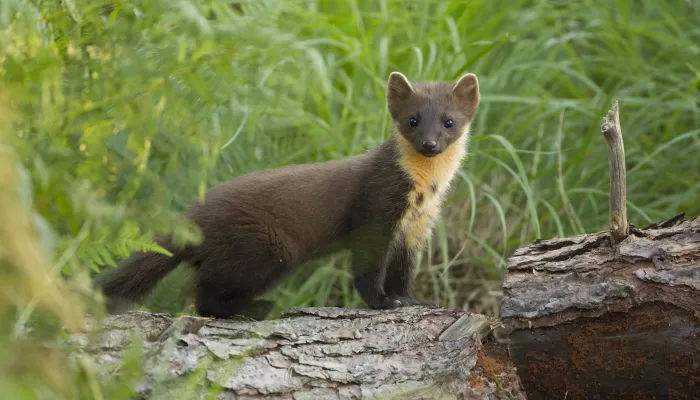
The following conversation starts at timestamp [45:25] in the podcast.
After the successful reintroductions of red-billed choughs and beavers. Now the South East Pine Marten Restoration Project is being launched, a joint scheme between Kent Wildlife Trust, Sussex Wildlife Trust, and the Wildwood Trust. They’re looking into the feasibility of bringing them back. I met up with some of the project leaders in Woodland near Benenden to hear all about it.
Amy: I'm Amy Fitzmaurice. I work for Kent Wildlife Trust. I am our Human-Wildlife Coexistence Officer.
Rob: So, pine martens. We're talking about pine martens. And we are in some beautiful woodland here near to sort of Benenden direction. And you want to see pine martens in these woods?
Amy: Yes, we would love to see pine martens back in the High Weald. There's lots of research over the years that suggests that the High Weald is one of the best places in the South East for them to be reintroduced. So we also did habitat feasibility to check that that's still the case and our modelling shows that it still is. And we're now in the process of doing ecological feasibility and obviously the habitat looks really good. We can hear lots of lovely birds chirping away in the background, but we want to make sure that there's enough food for pine martens to be able to eat, enough places for them to be able to have homes, and they like to sleep up in the trees.
So we need to make sure there's lots of old cavities in the trees to check that they have places to sleep. If not, we need to put up additional den boxes.
Rob: OK so what does an ecological survey actually mean? Does that mean you physically go round climbing up trees, having a look in places, seeing what's there?
Amy: So an ecological feasibility involves a lot of things. There are kind of two stages to an ecological feasibility. One is the core things that need to happen for us to be able to show that it's OK for pine martens to be there – so checking that they have a good food source, things like small mammals, that's their main food source and other things like grey squirrels and they like to eat berries in the autumn. So checking that they've got food source for that. The other side of the feasibility study is making sure that we're understanding what the ecosystem is like now before pine martens get put back and if they get put back. So that's things like understanding the birds, understanding, you know what insects are here, understanding what's happening in the system so that we have a ‘before’ and then we can put them back, and then we monitor, and then we have an ‘after’.
Rob: Am I right in thinking that there's a thought that says if you have pine marten, you're more likely to get red squirrels coming back again because they can't catch the red squirrels, but they can catch the greys – is that right?
Amy: Yeah. So because grey squirrels are fatter and slower and spend more time on the ground compared to red squirrels, they are easier to catch. So pine martens will have an impact on them through a multitude of factors: one, predation, but also a sort of landscape of fear. You know, having a predator back that is able to chase them, they might move to different areas and again if there's another pine marten, then they're gonna catch them.
Rob: So you'd like to see this as kind of like a first step in changing and bringing the ecology back here that you would have seen 2 or 300 hundred years ago effectively.
Amy: Yes, exactly. So where pine martens have been reintroduced, where grey squirrels and red squirrels are present, the grey squirrel population has gone down and the red squirrel population has slowly gone back up. So if we would ever like to do a red squirrel reintroduction down here in the South East then pine martens will lay the foundation for that to happen.
Matt: My name is Matt Phelps. I'm the Species Recovery Officer for Sussex Wildlife Trust.
Rob: OK, Sussex Wildlife Trust. This is a cross-border patrol going on then!
Matt: Yeah, absolutely. It's a really important collaborative project, the Pine Marten Project. We are working very closely with Kent Wildlife Trust. My role, which was a new role for Sussex Wildlife Trust last year, one of the priorities of that role is to collaborate with Kent on this project, partly because pine martens were across this region at one stage. If you go back a couple of hundred years they were right across the South East of England. And also because we're the sort of bridge between Hampshire and Kent and we know there is this population in the New Forest of pine martens. So how we can sort of act as a bridge between Kent and Hampshire basically.
Rob: I mean how far does a pine marten travel then, how big is their territory?
Matt: Their territories can be quite big so they can be sort of ten kilometres or more, but generally they are quite slow moving in terms of their dispersal. They are still one of the rarest mammals in Britain, coming back from when they were at a very, very low level. And there's been some reintroductions in places like the Forest of Dean, but the dispersal rate has tended to be relatively slow. So in the New Forest they have sort of moved out towards Dorset. We think they might be moving towards Sussex as well. And it's all about reconnecting these habitats. So, you know, making sure that there's lots of quality habitat not just for pine marten but a host of other wildlife as well.
Rob: And how do you know if a pine marten is in an area? Are they tagged, are you actually sort of tracking them or is this just keeping an eye out and seeing evidence of stuff they've eaten, that kind of thing?
Matt: Yeah. So there's multiple ways in which you can do it. And there has been projects where there's been GPS tagging. Camera trapping has been really, really important in other projects. So in the New Forest, Forestry England and other organisations were able to identify the population was there using camera traps. Otherwise it was all kind of anecdotal sightings. They're a very elusive species. So actually it tended to be people saying, “I think I've seen a pine marten.” There maybe were some that were found on roads – that is unfortunately a hazard for pine martens, particularly in the South East because there's a lot of roads. So it's bringing together all of the data through sort of anecdotal sightings and camera tracking and everything else.
Suzanne: Suzanne Kynaston. So I'm Conservation Officer at The Wildwood Trust. And so my job involves, I’m a project officer essentially. So I've worked on Hazel dormouse reintroduction, the red-billed chough reintroduction, and now working on pine marten restoration back to the South East.
Rob: I just want to do a little bit of kind of basic history on it. Why are there no Pine Martens here now? Because if you went back 2 or 300 years, they would’ve been a common species, wouldn't they?
Suzanne: Absolutely. Yeah, if we go right back to sort of Ice Age times, just after the Ice Age, they were the second most abundant carnivore in Britain. Now they're the second rarest carnivore in Britain. And that's mainly down to habitat loss. They've lost so much. Because they're essentially a woodland species. They are very adaptable and will use different habitats, but they always need a little bit of woodland in their home range. We have lost so much of that over, you know, the past hundreds of years essentially. And also they've been persecuted, they were regarded as vermin and so they were persecuted through the preservation of the Grain Act in medieval times. And ever since then they've been persecuted and their fur is very luxurious and was called ‘soft gold’. So it was actually used kind of as money in some respects.
Rob: But the persecution side of it – because, preserving grain, they don't eat grain! Was that just, people were confused?
Suzanne: Yeah, essentially. And it was to do also with the fact that they would eat game birds as well, which were used for sport.
Rob: Right.
Suzanne: So it was that kind of conflict. Yeah.
Rob: And has that been a thing in more modern times? Gamekeepers, have they been an issue for pine martens?
Suzanne: Yes, they have historically, you know, sort of early - earlier - sort of 1900s, they were very heavily persecuted by the gamekeepers. And now there's this kind of more understanding. And obviously pine marten are protected species. So that is sort of less of an issue in current times.
Rob: So let's assume that pine martens were to be released into the woods here. How would that happen? Would you literally just sort of open the cage and let them go and get on with it?
Suzanne: Absolutely not. So what essentially if we do get to that point - and that's kind of very important to say that you know we're not thinking about doing that immediately - if we get to the point where we want to reintroduce pine martens, then it would be a soft release. So it would be a case of building release cages and then they'd be in those for you know a few days and we'd be feeding them in the cages and then we’d let them go and there’d be an opportunity to come back to the cages to get food and everything if they needed it while they settled into the environment.
Rob: So I went and saw the red chough release cases over near Dover Castle a couple of months ago and it would be a similar kind of concept to that then?
Suzanne: Yes, now the chough project is slightly different because they are being, they're target trained and they're recalled by a target board and a whistle. They are basically kind of hefted to that site. So they go out every day but then they come back to the release aviary. The pine martens, I imagine, are going to be a little bit more independent. There's already been reintroductions in Wales and in the Forest of Dean and those pine martens, essentially when they left those enclosures, they didn't come back, they were kind of they, they worked it out straight away. Very independent.
Rob: Also with us was Sara Monroy from Kent Wildlife Trust, who has the official title of Landscape Community Organising Officer.
Sara: So we've been supporting the project, doing social feasibility, starting with the focus groups. We've been running sessions since January. We've been inviting people from different organisations on audiences and backgrounds for everybody to be able to get engaged in this project early on. So we've engaged in lots of different sessions, three venues, and we have reached out to different people and from there we've been pulling out some landowners and stakeholder organisations that would have allowed us to build on this possible engagement. Moving forward, the social feasibility this year would look into doing a questionnaire reach-out. We'll be looking to engage about 5,000 inhabitants of the High Weald and we are going to ask them different questions to understand how they are feeling about the project, if they know about the project, and what would they need in order to be ready to host pine marten in their landscape and doorstep.
Rob: And what kind of responses are you getting so far? How's it going?
Sara: It's super favourable. I think people are coming into our workshops and it's kind of a conversion therapy. So they come with apprehension, they come with the law, they come quoting different experiences that they have seen online. And after the full presentation and experience of being educated further into pine marten and these restoration projects, the methodology that we're working with, the ethos, the mission that we're working with, I think people are allowed to express their feelings. They're allowed to engage with a reliable pool of contacts and people--
Rob: I mean are people worried about pine martens coming and are they concerned there might be...?
Sara: I think there are some concerns on the table. But I think people have also acknowledged that this is a native species that has always been here and that therefore has the right place to be so. So I think finding that balance and allowing space for everybody is what is going to be key for this project to move forward.
Rob: Because it's not like trying to reintroduce wolves is it? You know, the fear factor is not there in that way?
Sara: No, not at all. I think as mentioned before, you're going to be very lucky if you actually have them in which is kind of like, we're looking for rather than compensation incentives for people that are allowed, that have allowed pine martens in. So I think that changing the power balance and allowing people to be early on acknowledged is the key element for this project to move forward. And landowners I think is especially - pieces of the jigsaw like mentioned earlier before. I think that's part of this landscape connectivity approach.
Rob: So what would you say to somebody who was concerned about pine martens coming back in? I don't know who would be, but what would you say to them?
Sara: To come and speak with us, let us know, let us know where they are, let us know what they do, let us know what is their agenda, day to day activities, and prioritisations for us to be able to acknowledge all those and to be able to integrate that into our coexistence strategy.
Matt: There's this perception that the South East is, is very busy and very sort of – there's no wild areas. Obviously there are a lot of human impacts in the South East, but actually there's still a tremendous amount of habitat and the Sussex, in particular, is one of the most wooded places in England. So this sort of High Weald corridor of woodland and then the South Downs and Woodlands out to the West of Sussex. There's some tremendous opportunities there for pine marten and also a host of other species as well because pine marten are a species which indicate that the habitat is very good and they actually require large joined-up habitats. They are what we call a flagship species, so they can be used as a kind of a driver for habitat improvement and connectivity, which is so important because our habitats have become very kind of fragmented, so there's plenty of places for them to live.
Rob: So Suzanne, once the pine martens have been released, assuming they're going to be in the future, once the pine martens have been released, what happens then? Do you just let them get on with it?
Suzanne: Yeah, absolutely not. So we do post-release monitoring, so we'll be potentially radio collaring the pine martens or it could be a GPS which is using satellites to track. So essentially we're going to be tracking where they go and also we'll have camera traps and we'll be doing den box checks. So we're certainly not just going to let them go. We're going to be following their movements and checking they're OK and sort of in the right places and all of that.
Rob: And is that just a kind of a sort of a welfare thing for the for the pine martens? Is that the point of doing it?
Suzanne: Yes. Well there's two strands here. It's obviously for the pine martens themselves you know to check that they're OK. But it's also so that we can inform people. So there's gonna be, there is a post-release monitoring strategy and that of course involves the pine martens themselves, but does involve the people. We want the people to kind of be on board with us and we want people to get involved and help you know monitor the pine martens potentially. We've already got 100 volunteers on board who want to help with the ecological feasibility. So hopefully they're going to help with the monitoring and then we want to interview those people as well and get their thoughts after the pine martens after the release. So they're all still happy about the project essentially.
Rob: And as a final thought then if people do want to get involved in this, how can they do it?
Suzanne: So they can visit any of our websites, they can visit Wildwood, they can visit Kent Wildlife Trust, they can visit Sussex Wildlife Trust. There's lots of information on there about how they can get involved and how they can contact us because we'd be happy to hear from them.
Rob: Many thanks to Sara and Suzanne and Matt and Amy for all of their time and it is a big project. In fact, there are something like 40 different stakeholder organisations involved in the project with a 10-year strategy. So while it will probably be a little while before pine martens are once again successfully living in the woodlands of Kent and Sussex, surely it’s going to happen. If you'd like to get involved or just to find out more then go to the Kent Wildlife Trust website and search for 'pine marten' - remember, you do spell marten ‘M-A-R-T-E-N', it's not with an ‘I’ - and you can find out all about it there.

Kent Wildlife Trust and Wildwood Trust, in collaboration with Sussex Wildlife Trust, Ashdown Forest and Forestry England, are assessing the possibility of restoring pine martens to the South East.
Largely confined to the north of the UK, the rare pine marten is nocturnal and very hard to spot. However, it can be enticed to visit a peanut-laden birdtable.

A run down and overgrown medieval churchyard in Sandwich has been restored to a beautiful wildlife haven by a group of local volunteers who live locally and are part of the congregation at the church. In this amazing story, you'll hear from the people who…
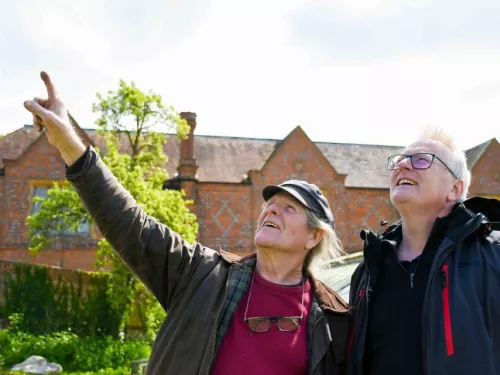
Iain Tolhurst NBE is a pioneering organic farmer and owner of Tolhurst Organic Farms. This farm has made quite a name for itself because it is able to feed 350 families on 14 acres of what is classified as poor quality agricultural land up to now, without…
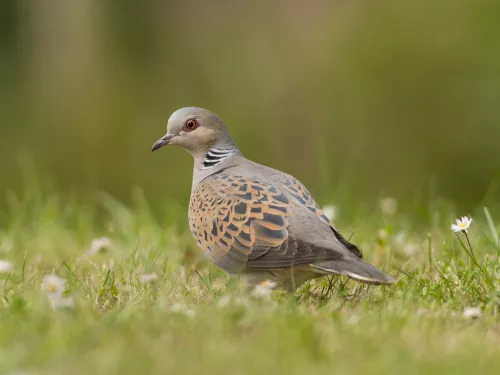
Join your Talk on the Wild Side host, Rob Smith, for a journey through Marden's farms and gardens - where farmers, scientists, and keen birders are working together to make space for the rare turtle fove.
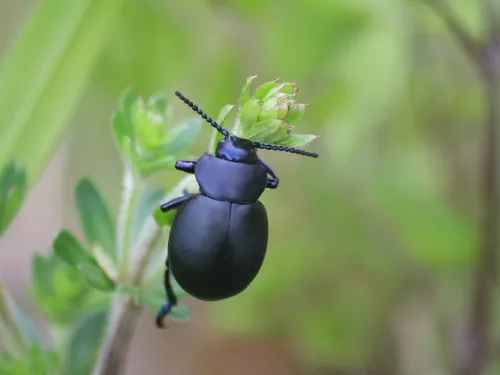
This is Talk on the Wild Side. I'm Rob Smith, and in this episode, bugs matter. And bugs really do matter. Don't just take my word for it. As Sir David Attenborough no less puts it, if we and the rest of the backboned animals were to disappear overnight,…